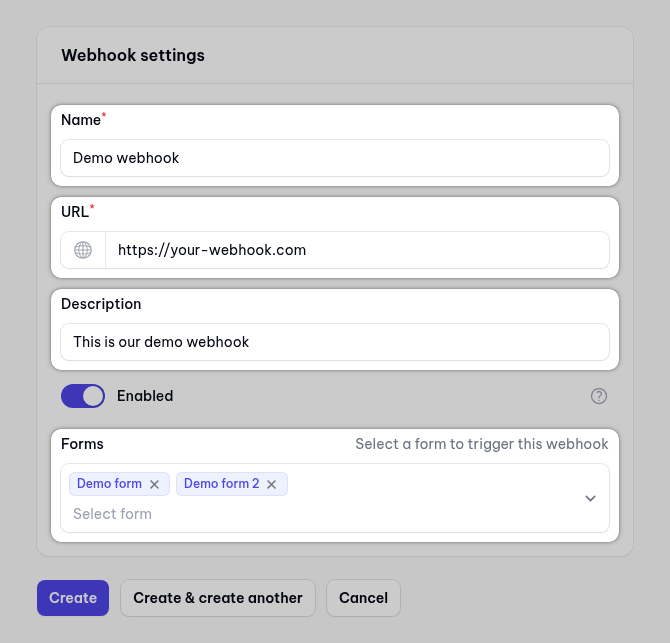Webhooks
Webhooks are a powerful way to send data from your Branchside forms to other applications in real-time. By providing a webhook URL, you can automatically push form submission data to external services the moment a form is submitted.
This allows you to connect Branchside to thousands of other apps using automation platforms like Zapier, Make, n8n, IFTTT or others.
For example, you could:
-
Send lead data directly to your CRM.
-
Add new contacts to an email marketing list.
-
Create rows in Airtable base.
-
Trigger custom workflows in other systems.
Log in to your account and navigate to the Webhooks page.
Click the "New webhook" button in the top-right corner.

Fill in your webhook details:
-
Name (required): a friendly name to help you identify the webhook (e.g., "New Lead to CRM").
-
URL (required): the unique URL provided by the external service that will receive the data.
-
Description: an optional description for more context.
-
Forms: select one or more forms that will trigger this webhook.

Click the "Create" button to save and activate your webhook.
With each form submission, Branchside will send a POST request to your webhook URL with a JSON payload. The payload example:
{
"form": {
"type": "base",
"id": "e7994b79-2a1d-4978-8c5a-94d95556b5b2",
"name": "Demo form",
"fields": {
"user.name": {
"type": "text",
"name": "user.name",
"label": "User name"
},
"user.email": {
"type": "text",
"name": "user.email",
"label": "User email"
}
}
},
"data": {
"user.name": "demouser",
"user.email": "[email protected]"
},
"structured_data": {
"user": {
"name": "demouser",
"email": "[email protected]"
}
},
"metadata": {
"time": 1762252573
}
}-
form.id: the unique ID of the form that was submitted. -
form.name: the name of the form as you set it in the dashboard. -
form.fields: an object containing the structure and properties of all fields in the form. -
data: an object containing the key-value pairs of the data the user actually submitted. -
structured_data: an object containing the submitted data organized into a nested structure based on field naming conventions. Fields with dot notation (e.g.,user.name,user.email) are automatically grouped into nested objects (e.g.,{user: {name: "...", email: "..."}}), making it easier to work with related fields. -
metadata.time: a Unix timestamp of when the form was submitted.
-
To ensure system stability, if a webhook URL fails to respond correctly (e.g., returns an error or times out) three consecutive times, Branchside will automatically disable it.
-
You will be notified by email if your webhook is disabled.